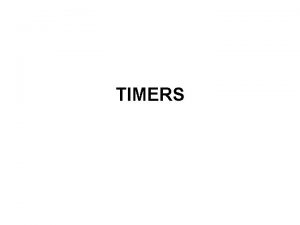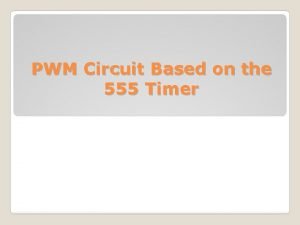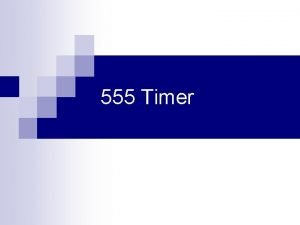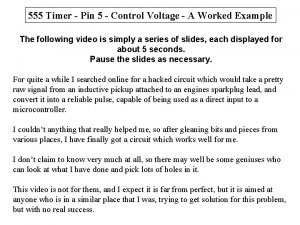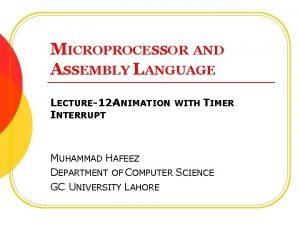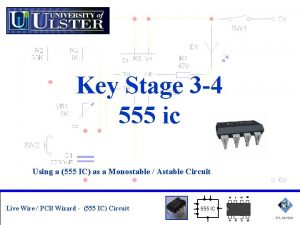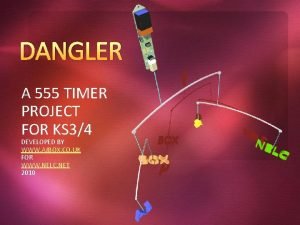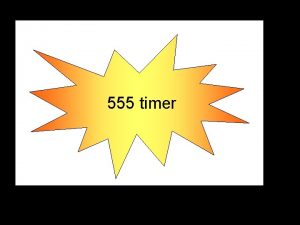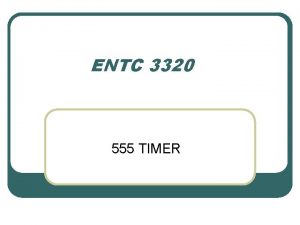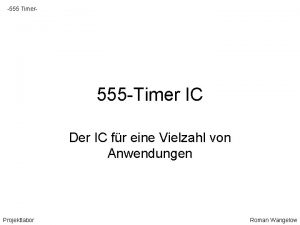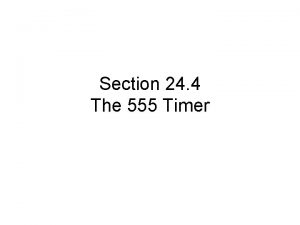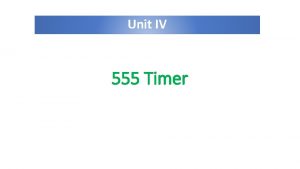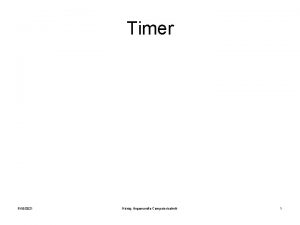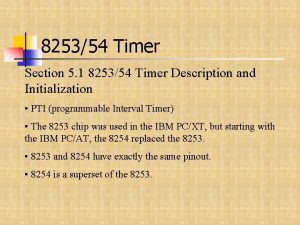Section 24 4 The 555 Timer Rectangular Waves



















- Slides: 19

Section 24. 4 The 555 Timer

• Rectangular Waves - Reminder: Duty Cycle – ratio of pulse width to cycle time where PW = the pulse width of the circuit input T = the cycle time of the circuit input 2

Rectangular Wave • If you repeatedly switch between the battery and the short you are effectively applying a rectangular time pulse to the RC circuit. a) If SW =. 5 PW, what is the duty cycle? b) If SW = PW, what is the duty cycle?

Rectangular Wave Response • The voltage across the capacitor will behave as below in response to such a wave:

In-Class Activity • For the circuit above, what value of C will allow the capacitor to “fully” charge and “fully” discharge if the square wave has a period of 2 ms? • What is the time constant for this circuit?

In-Class Activity • Determine the charging time constant and the discharging time constant in the circuit below:

555 Integrated Circuit Timer

Inside the 555 is a voltage divider

The 555 Compares the voltage at pin 6 to 2/3 Vcc The 555 Compares the voltage at pin 2 to 1/3 Vcc

Typical Wiring for a 555 (astable mode) Notice that the boxed area is just an RC circuit

Current Flow During Capacitor Charging The capacitor charges via RA and RB until vc = 2/3 Vcc

Capacitor Voltage and Output Voltage Vcc 0 Red arrows indicate voltages during charging phases

Current Flow During Capacitor Discharging The capacitor discharges through just RB until vc = 1/3 Vcc

Capacitor Voltage and Output Voltage Vcc 0 V Blue arrows indicate voltages during discharging phases

Timing During the charging phase, the capacitor voltage can be written as: During the discharging phase, the capacitor voltage can be written as:

In-Class Activity • How long does it take to: a) charge up from 1/3 Vcc to 2/3 Vcc? • Hint: Calculate time to reach voltage first then subtract • b) discharge from 2/3 Vcc to 1/3 Vcc

555 Timing • Pulse width – capacitor charging time: PW = (RA + RB)C ln(2) sec • Space width – capacitor discharging time: SW = RB C ln(2) sec • Period = Pulse width + Space width T = PW + SW = (RA + 2 RB)C ln(2) sec • Frequency – 1/Period f = 1/(RA + 2 RB)C ln(2) = 1. 443/(RA + 2 RB)C Hz

555 Duty Cycle • Duty Cycle = 100 PW/T % or

In-Class Activity • In Multisim, build this 555 circuit, use RA = RB = 1 kΩ and C = 1µF. • 555 can be found in Place. Mixed-Timer-LM 555 CM • What are the following: T, PW, SW, duty cycle, f? • Show them in hand calculations and record what you see on Multisim oscilloscope
 Bistable 555
Bistable 555 Pwm 555 circuit
Pwm 555 circuit 555 timer configuration
555 timer configuration 555 timer pin 5
555 timer pin 5 555 timer equations
555 timer equations 555 timer animation
555 timer animation Timer 555 w przykładach
Timer 555 w przykładach 555 timer metronome
555 timer metronome 555 timer pcb layout
555 timer pcb layout Lowest point of a wave
Lowest point of a wave Longitudinal wave vs transverse wave
Longitudinal wave vs transverse wave Examples of mechanical waves
Examples of mechanical waves What is a rainbow
What is a rainbow What type of waves are sound waves? *
What type of waves are sound waves? * Sound is a longitudinal wave
Sound is a longitudinal wave What is a semiconductor used for
What is a semiconductor used for Mechanical waves and electromagnetic waves similarities
Mechanical waves and electromagnetic waves similarities Mechanical vs electromagnetic waves
Mechanical vs electromagnetic waves Mechanical and electromagnetic waves similarities
Mechanical and electromagnetic waves similarities Seismic waves
Seismic waves
